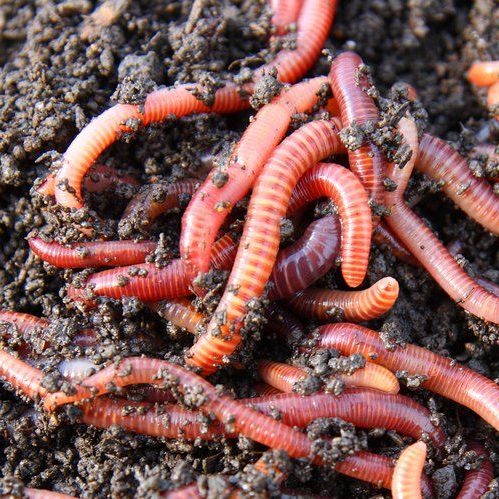Achieve a Vibrant Lawn Using Lake Hickory Bait Lawn Care Resources
Achieve a Vibrant Lawn Using Lake Hickory Bait Lawn Care Resources
Blog Article
Red Wigglers: The Unsung Heroes of Organic Waste Recycling
Red wigglers, or Eisenia fetida, offer as essential representatives in the organic waste reusing procedure, changing discarded materials into useful vermicompost. As the globe progressively seeks options to deal with waste buildup and boost agricultural productivity, understanding the function of these worms comes to be important.
What Are Red Wigglers?
The impressive resilience of red wigglers, scientifically referred to as Eisenia fetida, underscores their important duty in natural waste recycling. These small, reddish-brown earthworms are normally discovered in decaying raw material, such as compost heap and manure stacks. Lake Hickory Bait. Unlike various other earthworm types, red wigglers grow in nutrient-rich atmospheres and are extremely reliable at breaking down natural materials, making them important for vermicomposting

(Red Wiggler Express)Along with their role in waste reduction, red wigglers add to dirt health by enhancing soil framework and aeration with their tunneling tasks (Lake Hickory Bait). Their presence in composting systems not only improves decay prices yet also promotes a sustainable method to lose monitoring, highlighting their importance in environmental conservation efforts
Benefits of Composting With Worms
Composting with worms, specifically red wigglers, supplies numerous advantages that enhance both waste administration and soil health and wellness. These worms efficiently break down organic waste, converting it right into nutrient-rich vermicompost that improves dirt. This procedure increases disintegration, permitting for a faster recycling of kitchen scraps and various other natural materials compared to standard composting approaches.
In addition, the vermicompost generated by red wigglers is teeming with useful bacteria, which help improve soil framework, oygenation, and wetness retention. This improves the overall health of plants, advertising energetic growth and increased returns in yards and agricultural settings. The usage of worms in composting reduces the production of greenhouse gases, such as methane, adding to a much more lasting waste administration system.

How to Start Vermicomposting
Establishing a vermicomposting system is an uncomplicated procedure that can produce considerable benefits for both waste administration and dirt enrichment. To begin, choose an appropriate container, such as a plastic container or wood box, with ample ventilation holes to guarantee appropriate air flow. The measurements need to preferably be about 2 feet by 3 feet, permitting ample space for the worms to thrive.
Following, prepare bed linen product, which can contain shredded paper, cardboard, or coconut coir. This bed linen must be dampened to produce an appropriate environment for the worms. When the bed linen is in place, introduce red wigglers (Eisenia fetida) into the container, generally around one pound of worms for every square foot of area.
Complying with the positioning of worms, include organic waste, such as fruit and vegetable scraps, coffee premises, and smashed eggshells. With these steps, you will effectively launch a vermicomposting system that contributes to sustainable waste monitoring and enhances your dirt.
Preserving a Healthy Worm Bin
(Red Wiggler Express)Keeping a worm container thriving needs regular attention and treatment to ensure the wellness of the red wigglers and the efficiency of Red Wiggler Express the composting process. Proper maintenance begins with checking the dampness levels; the container needs to be moist but not soaked. An excellent policy of thumb is to maintain a consistency comparable to a wrung-out sponge.
Delicately mixing the bedding and food scraps every few weeks stops compaction and makes certain that all worms have access to oxygen. Furthermore, it is crucial to feed the worms suitably.
Temperature level regulation is another important element. Red wigglers grow in a variety of 55 to 77 levels Fahrenheit. If the container becomes too hot or chilly, the worms might become stressed out - Lake Hickory Bait. Lastly, periodically look for indicators of health, such as worm population growth and the presence of healthy and balanced spreadings. By diligently managing these factors, one can keep a durable and effective worm container.
Influence on Lasting Living
The successful maintenance of a worm bin not only benefits the wellness of red wigglers yet likewise contributes considerably to sustainable living techniques. By reusing organic waste, such as kitchen scraps and backyard debris, red wigglers help draw away considerable amounts of product from garbage dumps. This reduction in waste not just decreases greenhouse gas exhausts however also decreases the ecological burden linked with waste administration.
Furthermore, the spreadings created by red wigglers serve as a nutrient-rich natural fertilizer, boosting soil wellness and promoting plant development. This natural choice to chemical fertilizers sustains lasting agriculture and horticulture practices, reducing dependence on synthetic inputs that can hurt ecological communities. Additionally, worm composting fosters understanding of waste management, motivating people and neighborhoods to adopt even more sustainable practices.

Final Thought
In recap, red wigglers work as vital contributors to organic waste recycling through their efficient decay of organic products. Their ability to generate nutrient-rich vermicompost boosts dirt health and supports lasting farming techniques. By incorporating vermicomposting right into waste monitoring approaches, people and areas can dramatically lower waste while advertising ecological sustainability. The function of Eisenia fetida in promoting healthy environments highlights the significance of these organisms in achieving lasting living and boosting dirt fertility.
Report this page